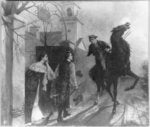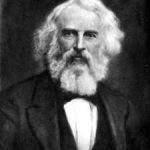Guiding Question – Why did we go to War?
Focus Words – Freedom/Independence/Liberty
Introduction:
1) Introduce “Paul Revere’s Ride” through one of the videos and KWL Chart.
Ask students:
What do you know about Paul Revere?
Why is it important to know about Paul Revere?
Why did Paul Revere find it necessary to warn others?
- Andy Griffith explains Paul Revere’s Ride:
- Cartoon version Teacher Registration needed
- Dramatized history (a few curse words/very dramatic)
2) Read “Paul Revere’s Ride” by Longfellow or use audio:
- Audio online: Recited by William Sterling Battis – 4/29/1916Ask students: What did you notice?
What is the setting?
How was this different from the introduction video?
Who were the characters in the poem? Use F.A.S.T. Activity.
Paul Revere’s Ride (click here to print out)
By Henry Wadsworth Longfellow (1807-1882)
Listen my children and you shall hear
Of the midnight ride of Paul Revere,
On the eighteenth of April, in Seventy-five;
Hardly a man is now alive
Who remembers that famous day and year.
He said to his friend, “If the British march
By land or sea from the town to-night,
Hang a lantern aloft in the belfry arch
Of the North Church tower as a signal light,–
One if by land, and two if by sea;
And I on the opposite shore will be,
Ready to ride and spread the alarm
Through every Middlesex village and farm,
For the country folk to be up and to arm.”
Then he said “Good-night!” and with muffled oar
Silently rowed to the Charlestown shore,
Just as the moon rose over the bay,
Where swinging wide at her moorings lay
The Somerset, British man-of-war;
A phantom ship, with each mast and spar
Across the moon like a prison bar,
And a huge black hulk, that was magnified
By its own reflection in the tide.
Meanwhile, his friend through alley and street
Wanders and watches, with eager ears,
Till in the silence around him he hears
The muster of men at the barrack door,
The sound of arms, and the tramp of feet,
And the measured tread of the grenadiers,
Marching down to their boats on the shore.
Then he climbed the tower of the Old North Church,
By the wooden stairs, with stealthy tread,
To the belfry chamber overhead,
And startled the pigeons from their perch
On the sombre rafters, that round him made
Masses and moving shapes of shade,–
By the trembling ladder, steep and tall,
To the highest window in the wall,
Where he paused to listen and look down
A moment on the roofs of the town
And the moonlight flowing over all.
Beneath, in the churchyard, lay the dead,
In their night encampment on the hill,
Wrapped in silence so deep and still
That he could hear, like a sentinel’s tread,
The watchful night-wind, as it went
Creeping along from tent to tent,
And seeming to whisper, “All is well!”
A moment only he feels the spell
Of the place and the hour, and the secret dread
Of the lonely belfry and the dead;
For suddenly all his thoughts are bent
On a shadowy something far away,
Where the river widens to meet the bay,–
A line of black that bends and floats
On the rising tide like a bridge of boats.
Meanwhile, impatient to mount and ride,
Booted and spurred, with a heavy stride
On the opposite shore walked Paul Revere.
Now he patted his horse’s side,
Now he gazed at the landscape far and near,
Then, impetuous, stamped the earth,
And turned and tightened his saddle girth;
But mostly he watched with eager search
The belfry tower of the Old North Church,
As it rose above the graves on the hill,
Lonely and spectral and sombre and still.
And lo! as he looks, on the belfry’s height
A glimmer, and then a gleam of light!
He springs to the saddle, the bridle he turns,
But lingers and gazes, till full on his sight
A second lamp in the belfry burns.
A hurry of hoofs in a village street,
A shape in the moonlight, a bulk in the dark,
And beneath, from the pebbles, in passing, a spark
Struck out by a steed flying fearless and fleet;
That was all! And yet, through the gloom and the light,
The fate of a nation was riding that night;
And the spark struck out by that steed, in his flight,
Kindled the land into flame with its heat.
He has left the village and mounted the steep,
And beneath him, tranquil and broad and deep,
Is the Mystic, meeting the ocean tides;
And under the alders that skirt its edge,
Now soft on the sand, now loud on the ledge,
Is heard the tramp of his steed as he rides.
It was twelve by the village clock
When he crossed the bridge into Medford town.
He heard the crowing of the cock,
And the barking of the farmer’s dog,
And felt the damp of the river fog,
That rises after the sun goes down.
It was one by the village clock,
When he galloped into Lexington.
He saw the gilded weathercock
Swim in the moonlight as he passed,
And the meeting-house windows, black and bare,
Gaze at him with a spectral glare,
As if they already stood aghast
At the bloody work they would look upon.
It was two by the village clock,
When he came to the bridge in Concord town.
He heard the bleating of the flock,
And the twitter of birds among the trees,
And felt the breath of the morning breeze
Blowing over the meadow brown.
And one was safe and asleep in his bed
Who at the bridge would be first to fall,
Who that day would be lying dead,
Pierced by a British musket ball.
You know the rest. In the books you have read
How the British Regulars fired and fled,—
How the farmers gave them ball for ball,
From behind each fence and farmyard wall,
Chasing the redcoats down the lane,
Then crossing the fields to emerge again
Under the trees at the turn of the road,
And only pausing to fire and load.
So through the night rode Paul Revere;
And so through the night went his cry of alarm
To every Middlesex village and farm,—
A cry of defiance, and not of fear,
A voice in the darkness, a knock at the door,
And a word that shall echo for evermore!
For, borne on the night-wind of the Past,
Through all our history, to the last,
In the hour of darkness and peril and need,
The people will waken and listen to hear
The hurrying hoof-beats of that steed,
And the midnight message of Paul Revere.
3) Ask: What does the poem tell us about Henry Wadsworth Longfellow?
What was his ethnicity?
Research on Longfellow
Does the vocabulary give us some ideas about Longfellow? See Vocabulary
What perspective and/or point of view is Longfellow using in the poem?
- To explore a different point of view use this book.
4) Divide into groups to jigsaw read “Paul Revere’s Ride” by Longfellow.
Ask students: What rhythm, rhyme and figurative language do you hear in this poem?
Play
5) Plan to perform/dramatize your part when the class comes back together.
Standards, Goals and Objectives:
Language Arts-
1. 5.RL.5.2 Determine a theme of a story, drama, or poem from details in the text, including how characters in a story or drama respond to challenges or how the speaker in a poem reflects upon a topic; summarize the text.
- Students will determine the overarching theme of these three poems, written by three very different poets in response to events in our nation’s history.
- Students will determine how characters in the poem respond to challenges set before them.
- Students will summarize the text.
2. 5.RL.5.6 Describe how a narrator’s or speaker’s point of view influences how events are described.
- Students will listen to various performances and describe how the point of view influences how events are described.
Social Studies-
1. 5. C.1.4 Understand how cultural narratives (legends, songs, ballads, games, folk tales and art forms) reflect the lifestyles, beliefs and struggles of diverse ethnic groups.
- Students will determine how the lifestyle, beliefs, and struggles of the authors were reflected in their poetry.
Materials Needed
Projector
Computer/Speakers
Paper- 81/2 X 11 and print paper roll
Vocabulary
Longfellow Poem- cut into parts for groups
“Mr. revere and I” by Robert Lawson
Author’s purpose worksheet, pg.29
Activities
- Watch Video and fill in KWL chart
- Listen to Longfellow’s poem continue with KWL chart
- F.A.S.T. to understand characters in the poem
- Explore Longfellow as a person – vocabulary
- Review poem again (jigsaw) with exploration of rhythm, rhyme and figurative language
- Dramatize the poem
Resources
Route that Paul Revere rode that night
Historical background of Paul Revere and the ride
Paul Revere’s Speech
What kind of music would Paul Revere have been hearing in his day?
What did Revere look like?
Paul Revere, the torch bearer of the revolution (1916 book by Belle Moses0
Paul Revere’s ride, and other poems
by Henry Wadsworth Longfellow; with explanatory notes. Published 1894 by Houghton Mifflin and Co. in Boston, New York [etc]
The true story of Paul Revere, his midnight ride, his arrest and court-martial, his useful public services
About the Author
Janet H. Berry, jberry@iss.k12.nc.us
Mrs. Berry has taught K-5 general music at Celeste Henkel Elementary/Iredell-Statesville Public Schools in Statesville, NC from Aug. 2005 to present. Mrs. Berry was Celeste Henkel’s Teacher of the Year 2011-2012 and a District Top Five Teacher of the Year that same year. Mrs. Berry holds Bachelor’s and Master’s of Music Education from Appalachian State University, Boone, NC,Orff Certification–Level III, Kodaly Level II.
About Banner Moments
Made available as part of the 2014 Banner Moments K-12 Institute—a project of the American Music Institute of the University of Michigan and the Star Spangled Music Foundation, sponsored by the National Endowment for the Humanities




